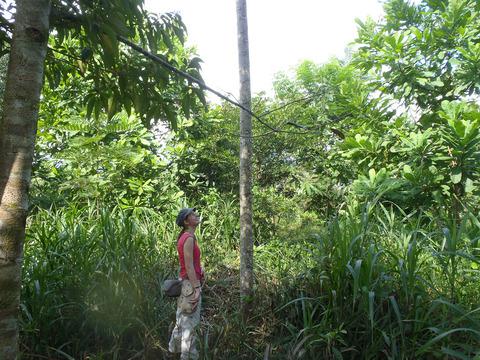当前位置:
X-MOL 学术
›
Funct. Ecol.
›
论文详情
Our official English website, www.x-mol.net, welcomes your
feedback! (Note: you will need to create a separate account there.)
Successional habitat filtering of rainforest trees is explained by potential growth more than by functional traits
Functional Ecology ( IF 4.6 ) Pub Date : 2020-05-02 , DOI: 10.1111/1365-2435.13571 Svenja Kleinschmidt 1 , Wolfgang Wanek 2 , Felix Kreinecker 1 , Daniel Hackl 1 , Daniel Jenking 3 , Anton Weissenhofer 4 , Peter Hietz 1
中文翻译:

雨林树木的连续生境过滤可以通过潜在的增长而不是通过功能性特征来解释
更新日期:2020-05-02
Functional Ecology ( IF 4.6 ) Pub Date : 2020-05-02 , DOI: 10.1111/1365-2435.13571 Svenja Kleinschmidt 1 , Wolfgang Wanek 2 , Felix Kreinecker 1 , Daniel Hackl 1 , Daniel Jenking 3 , Anton Weissenhofer 4 , Peter Hietz 1
Affiliation

|
- Species along successional gradients differ in functional traits, which may function as environmental filters and also explain differences in growth rates. Alternatively, species might be filtered by growth rates and these are explained by differences in other traits. We explored the relationships between leaf and wood traits, growth and successional habitat, and asked if growth is related to habitat because both are driven by a similar set of traits or if growth is the main trait explaining habitat and relationships with other traits are indirect.
- Tropical trees are often classified as second‐growth (SG) or old‐growth (OG) specialists, and generalists. Since succession is a continuous process and lumping species into three groups may not do justice to gradual differences, we tested if a continuous variable based on relative tree abundance in OG and SG forests might be a better predictor than classifying trees' habitat preferences into categories.
- We measured the height growth of 47 trees species planted in a reforestation trial in Costa Rica and evaluated size‐standardized potential growth during the first years when there was little shading among trees. Growth and habitat were related to wood density (WD), theoretical hydraulic conductivity (Kh), specific leaf area (SLA), leaf dry matter content (LDMC) and leaf nitrogen content (N).
- Potential growth rates and Kh were significantly correlated with habitat measured on a continuous scale, while growth and LDMC differed among the three groups of habitat specialization. Growth was also correlated with WD and Kh.
- Habitat specialization was correlated with the first principal component of the functional traits space. However, structural equation models suggest that the relationship with leaf and wood traits is mostly indirect and potential growth is the most important trait directly related to environmental filtering along a successional gradient. In our dataset, classifiying the successional status of species using the proportion of records from OG forests explains traits about as well as a classification into three groups, but provides more information about the species' position along the successional gradient.
中文翻译:

雨林树木的连续生境过滤可以通过潜在的增长而不是通过功能性特征来解释
- 沿演替梯度的物种在功能特征上有所不同,这可能充当环境过滤器,也可以解释增长率的差异。另外,物种可能会被生长速度过滤掉,而这些是通过其他性状的差异来解释的。我们探讨了叶片和木材性状,生长与演替栖息地之间的关系,并询问生长是否与栖息地有关,因为两者都是由一组相似的性状驱动的,或者生长是否是解释栖息地的主要性状以及与其他性状的关系是间接的。
- 热带树木通常被分为二次生长(SG)或陈年生长(OG)专家和通才。由于演替是一个连续的过程,将物种分为三类可能无法弥补渐进的差异,因此我们测试了基于OG和SG森林中相对树木丰富度的连续变量是否可能比将树木的生境偏好分类为更好的预测指标。
- 我们测量了哥斯达黎加一项重新造林试验中种植的47种树种的高度生长,并评估了树间几乎没有阴影的最初几年中以尺寸标准化的潜在生长。生长和栖息地与木材密度(WD),理论水力传导率(Kh),比叶面积(SLA),叶干物质含量(LDMC)和叶氮含量(N)有关。
- 在连续的尺度上,潜在的生长速率和Kh与生境显着相关,而在生境专业化的三组之间,生长和LDMC则有所不同。生长也与WD和Kh相关。
- 生境专业化与功能性状特征空间的第一个主要组成部分相关。然而,结构方程模型表明,与叶片和木材性状的关系大部分是间接的,而潜在的生长是最重要的性状,与沿梯度的环境过滤直接相关。在我们的数据集中,使用OG森林记录的比例对物种的演替状态进行分类,可以解释有关特征以及将其分为三类,但可以提供有关物种在演替梯度中的位置的更多信息。









































 京公网安备 11010802027423号
京公网安备 11010802027423号